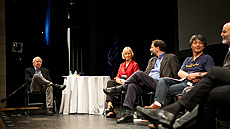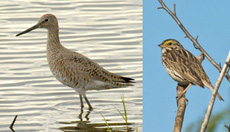|
Monday, June 16
- Breakfast: blueberry pancakes
- Breakfast: sausage, egg and cheese croissant
- Philly-style cheesesteak with peppers
- Smart cuisine: chicken Creole
- Poached salmon
- Spicy Asian chicken wrap
- Stir-fry sensations
- Corn chowder
- Texas-style chili
- Assorted pizza by the slice
Wilson Hall Cafe menu
|
|
Wednesday, June 18
Lunch
- Summer herb chimichurri with grilled steak
- Roasted potatoes
- Sauteed tri-color peppers
- Chocolate caramel cake
Friday, June 20
Dinner
5:30 p.m.
- Haricots verts and grape tomato salad with creme fraiche dressing
- Lobster tail with champagne butter sauce
- Spaghetti squash with scallions
- Sauteed sugar snap peas
- Mixed berry pie
Chez Leon menu
Call x3524 to make your reservation.
|
|
IPPOG involvement: forum for idea exchange
 |
Students at Universidad Iberoamericana in Mexico participate in an IPPOG International Masterclass. Photo: Fabiola Vazquez
|
A few years ago, QuarkNet staff teacher Ken Cecire told colleagues at a meeting of the International Particle Physics Outreach Group about the U.S. QuarkNet program. Today, there is a similar program in Germany.
The ideas exchanged during IPPOG meetings are just one way in which the network promotes increased education and outreach in particle physics throughout the world. Its members and associate members (those who are part of a project, such as Cecire) represent the 21 member states of Ireland, Romania, South Africa, the United States, CERN and DESY laboratories, and five of the major experiments at the LHC.
While Fermilab isn't an IPPOG member, Marge Bardeen, who heads the laboratory's Education Office, is the U.S. representative selected by the American Physical Society's Division of Particles and Fields. She and Hans Peter Beck, Switzerland, co-chair IPPOG. They were elected by the members for a three-year term that began in 2013. Bardeen was a member for several years before becoming co-chair. In addition to her administrative role, Bardeen shares Fermilab's education and outreach programs, ideas and initiatives and brings back ideas to implement here.
IPPOG's members and associate members execute the organization's outreach mission by growing and maintaining a resource database for physicists, teachers, students and the public. They also coordinate International Masterclasses, which give students from around the world the opportunity to talk with physicists and analyze real scientific data from the LHC experiments.
Cecire, an associate member of IPPOG, works through QuarkNet and the University of Notre Dame to coordinate the International Masterclasses with a colleague at TU Dresden. He also leads a team that has developed and maintains the CMS Masterclass measurement. There are also ATLAS, ALICE and LHCb Masterclass measurements. His work largely benefits the students who participate in the masterclasses, but the ideas he brings to IPPOG and those ideas he brings home are of great benefit to QuarkNet and the educators he works with, as well as to Fermilab and its outreach initiatives.
"Fermilab is one of the main centers where physicists moderate the masterclass events, so students are exposed to the lab and get to meet and talk with Fermilab physicists," Cecire said.
IPPOG also provides an environment where members can strategize with their colleagues about how to solve issues relating to particle physics communication, education and outreach in their home countries or organizations.
"There are a lot of common ideas about what education and outreach can be in our research community," Bardeen said. "It is important to encourage the next generation of scientists and share the value and excitement of our research with the general public."
—Rhianna Wisniewski
|
Researchers imagine the accelerators of the future
 |
At the LHC Physics Conference in New York, experts looked to the next steps in collider physics. Photo courtesy of Columbia University
|
In the late 1800s, many scientists thought that the major laws of physics had been discovered — that all that remained to be resolved were a few minor details.
Then in 1896 came the discovery of the first fundamental particle, the electron, followed by the discovery of atomic nuclei and revolutions in quantum physics and relativity. Modern particle physics had just begun, said Natalie Roe, the director of the Physics Division at Lawrence Berkeley National Laboratory, at the recent Large Hadron Collider Physics Conference in New York.
Since then, physicists have discovered a slew of new elementary particles and have developed a model that accurately describes the fundamental components of matter. But this time, they know that there is more left to find — if only they can reach it. In a presentation and a panel discussion chaired by New York Times science reporter Dennis Overbye, experts at the LHCP Conference discussed the future of collider-based particle physics research.
The discovery of a Higgs boson bolstered physicists' confidence in the Standard Model — our best understanding of matter at its most fundamental level. But the Standard Model does not answer important questions such as why the Higgs boson is so light or why neutrinos have mass, nor does it account for dark matter and dark energy, which astronomical observations indicate make up the majority of the known universe.
"We know that the Standard Model is not a complete theory because many outstanding questions remain," said CERN physicist Fabiola Gianotti, the former head of the ATLAS experiment at the LHC, at the LHCP Conference. "We must ask, at what energy scales do these questions find their answers?"
The LHC will access an energy level higher than any previous accelerator, up to 13 trillion electronvolts, when it restarts in 2015. Scientists are already thinking about what could come next, such as the proposed International Linear Collider or hadron colliders under discussion in Europe and Asia.
Building any proposed future accelerator will not be easy, "and none of them are cheap," Gianotti said. However, one should not discount the opportunities that technological advances can afford.
Gianotti pointed out that, in a 1954 presentation to the American Physical Society, Nobel Laureate Enrico Fermi estimated that an accelerator capable of accessing up to an energy of 3 trillion electronvolts would need to encircle the Earth and would cost about $170 billion.
Thanks to the development of colliders and superconducting magnets, the 17-mile-long LHC has reached an energy level more than twice as high for a small fraction of Fermi's estimated cost.
Read more
—Sarah Charley
|
|
The new look of Fermilab's eastern lakes
 |
| The willet (left) and Savannah sparrow are just two of the species that have returned to the Fermilab grounds since the water levels at A.E. Sea and DUSAF pond have been lowered. Photos: Dave Spleha |
Have you noticed the changes over the last couple of years in DUSAF pond and A.E. Sea, near Fermilab's east entrance? The lakes were lowered to decrease flooding in the Village and to alleviate a number of harmful impacts across many different systems. In addition to contributing to unsafe driving conditions when water floods over the roadway, the high water levels also intensified the pressure and infiltration of water into the sanitary sewers, saturated wooden building support structures and severely tested an outdated storm sewer system made of clay bricks that were never meant to be constantly submerged.
A.E. Sea was designed to be a retention basin with a lower average water height and extra space to hold additional water in the case of a short, heavy storm or flash flood. However, for a number of years, A.E. Sea was purposefully kept at its maximum water height to store water on site, which resulted in A.E. Sea essentially losing all stormwater retention capabilities as originally designed.
The expectation that the eastern lakes were kept high to serve as a backup cooling water supply for the hot summer months is inaccurate. When the lab took steps to limit the release of tritium in 2005, DUSAF pond and A.E. Sea (and the Ferry Creek outlet) were intentionally isolated from the process water supply. And during the few times that the eastern lakes have been used as a backup water supply, it has taken herculean efforts to draw water from these lakes for introduction and use in the cooling water system. These efforts also took place prior to identifying three other higher-priority make-up water supplies: water from the 300-foot-deep Minos tunnel, well number 4, which is on site, and the Fox River.
The lowering of lake levels has brought about ecological benefits, including an abundance of new avian visitors. Nineteen species of shorebirds have graced the newly lowered eastern lakes of Fermilab over the last year, including the willet, a larger shorebird found only a handful of times previously at Fermilab. A true measure of the health of any ecosystem is its diversity, which appears to have been increasing with multiple varieties of sandpipers, dabbling ducks and sparrows visiting the new lakes. One of the rarest of birds found in the Midwest is a white-faced ibis, which had its first confirmed sighting at the lab in April 2013.
It's exciting to think of what rarity might pop up next in the new, improved eastern lakes of Fermilab.
—Kate Sienkiewicz
|
Killdeer, bok choi and basil
 |
| Two killdeer nest in the Fermilab garden plot belonging to Daniel Mohler, PPD, and his wife Julianna Holden Mohler. The female has lain two eggs, seen here nestled in the woodchips beneath the bird and among bok choi and purple basil. Killdeer typically lay four eggs in a clutch. Photo: Julianna Holden Mohler
|
|
10 reasons why you can't live without a particle accelerator
From Nautilus, June 12, 2014
Physicists use particle accelerators to answer questions of fundamental physics — how our universe was created, why objects have mass, and so on. Accelerators are huge — Fermilab's Tevatron, near Chicago, is four miles in circumference, while the Large Hadron Collider in Geneva is more than four times that size — and extremely expensive. In some ways, they're the epitome of the pure research instrument. But if you think these machines have no use outside of research, you're in for a surprise.
Particle accelerators have been winding their way out of research labs and into industry for decades, and new applications continue to be dreamt up. When federal money for fundamental research dwindled, scientists started to invent new funding methods. Robert Kephart, director of the Illinois Accelerator Research Center (IARC) at Fermilab, partnered with the Illinois State Department of Commerce and Economic Opportunity to fund science research and applied applications of accelerators. In its 2009 capital bill, the state allocated $20 million toward research at Fermilab, which will be raised the same way states raise money to build roads and bridges — by selling state bonds.
Here are 10 applications of accelerators you probably haven't heard of.
Read more
|
|